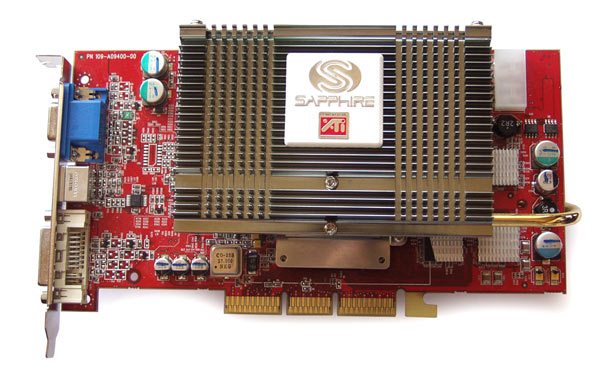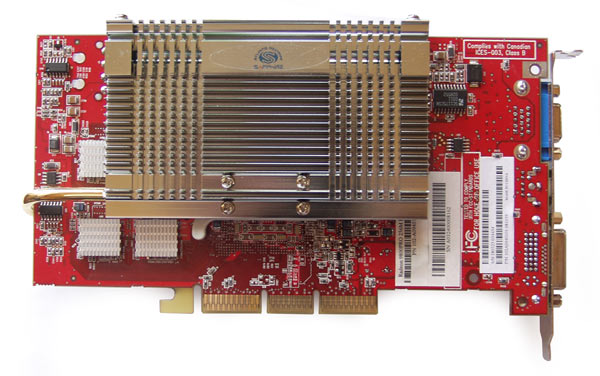A Roundup of ATI Radeon 9800 PRO video cards
Sapphire Atlantis Radeon 9800 PRO Ultimate Edition 256MB
Can you imagine the world's most powerful and absolutely noiseless video card? Especially those NVIDIA's roaring coolers for GeForce FX? Can you? But Sapphire Technology can - the company produced such a video card dubbed Sapphire Atlantis Radeon 9800 PRO Ultimate Edition! As the name suggests, this card is based on the GPU Radeon 9800 PRO and offers 256 MB onboard memory. So we are gladly presenting it.
 Sapphire Radeon 9800 PRO Ultimate Edition front; *1200x741 188 kb
Sapphire Radeon 9800 PRO Ultimate Edition front; *1200x741 188 kb
 Sapphire Radeon 9800 PRO Ultimate Edition back; *1200x752 189 kb
Sapphire Radeon 9800 PRO Ultimate Edition back; *1200x752 189 kb
Specifications
| Sapphire Atlantis Radeon 9800 PRO Ultimate Edition 256MB |
| GPU |
ATI RADEON 9800 PRO |
| Memory (Max) |
256 MB DDR-II SDRAM 2.2 ns |
| Memory/processor clock speed |
380/350(700) MHz |
| RAMDAC Frequency |
400 MHz |
| API |
OpenGL, DirectX, Direct3D |
| Support for two monitors |
Yes |
| Video Output |
2048 x 1536 / 60 Hz - 24-bit (16.7M colors) |
| Interface |
AGP 8X |
| Ports and connector type |
1 x DVI-Analogue Digital - 29 pin DVI
1 x VGA - 15 pin HD D-Sub (HD-15)
1 x S-video output |
| Maximum resolution |
2048x1536 / 60 Hz |
Cooling system
The cooling system of the board is made by ZALMAN, the manufacturer of world's quietest coolers. The system itself is made up of two massive aluminum radiators joined with a copper tube filled with some low-boiling-point fluid (such tubes are used by ABIT in their legendary OTES cooling system as well as by NVIDIA in its faulty FX Flow). The operation principle is simple - as the front radiator heats up, the fluid in the tube boils and transmits heat to the rear radiator of the card. To provide better heat transfer, thermal conductive paste is applied at the points of contact with the radiator. The radiators themselves are attached firmly to the board and one another, so you can safely forget about the concerns that the cooling system is poorly fastened or the nightmare dreams in which the radiator falls off during the gameplay.

As is known, there a fly in the ointment. Our case was no exception - forget about the couple of neighboring PCI slots: the problem is no longer topical nowadays when every normal motherboard offers at least 5 PCI slots. We ignore the Mini-ATX system, because Mini-ATX and Radeon 9800 PRO are incompatible by definition. Another shortcoming of this cooling system is the complete lack of air circulation near the memory chips which heat up immensely as we could make sure with the previously reviewed video card. Additionally, the radiators of the card heat up immensely during operation, which makes the air around the chip too hot and definitely not improves stability of the sensitive and capricious DDR-II memory. In fact, during those 6 hours of continuous operation not a single artifact or bug was detected - the card was as stable as rock.
The video card layout
On the board, I found connectors for plugging in the power supply of the cooler and a peculiar radiator cut on the chip closest to the GPU. This points to the fact that at the production stage there is no distinction between the regular and Ultimate versions of the cards - all the boards are within the same workflow, then they are equipped with regular coolers or the ZALMAN cooling system.
The board itself is made following the reference design and is absolutely identical to that previously reviewed video card made by Gigabyte. The boards differed only in the sticker on the rear side. At that, all mentioned about the Gigabyte board equally applies to the Sapphire video card. The box and the package bundle of the board merits a special mention. Which we'll be doing now.
The video card and package bundle
Unlike its Radeon 9700 PRO-based predecessor, this card was packaged into a nice-looking smart and stylish black box.
On the rear side, there is a viewing window through which you can see the card's cooling system - the box is simply a pleasure to hold such a card on hands. That applies to removing the contents:
- The board itself (fancy that! they didn't forget to put it inside either :) )
- A drivers CD
- S-Video and RCA extension cords
- Additional power cable
- DVI -> D-Sub adapter
- The user's manual is made in multiple languages except Russian.
- Sapphire RedLine tweaking software for fine tuning and overclocking of the video card
- Licensed versions of the PowerDVD XP 4.0 and PowerDirector VE 2.55 software
- Licensed version of the omni-favorite Return To Castle Wolfenstein game that is shipped on 2 CDs
- Licensed version of the 'Soldier Of Fortune II' game, on 2 CDs.
It's always a pleasure to see fast and well-made video cards, and this one packaged in a nice box with a rich package bundle is twice as better. That's all about the card.
Sapphire RedLine
Like Gigabyte, Sapphire offers its own utility for fine optimization of the card - RedLine, with the only difference that the V-Tuner is designed for overclocking, while RedLine is meant for tweaking the card. This utility allows to finely tune the card's parameters as well as select one of the pre-set optimization profiles. RedLine offers profiles for most games and applications, e.g. 3DMark2001, RTCW, Q3, Medal of Honor, Max Payne.
This is very handy because you don't have to manually select the optimum settings for a specific application, and those who are into the settings internals can make use of the fine tuning for multiple parameters.
RedLine works with almost all ATI Radeon video cards, and the card doesn't have to be manufactured by Sapphire. For instance, I started RedLine absolutely safely on the Radeon 9800 PRO reference board.
All the parameters are gathered on several tabs. It's also possible to choose the operation mode for the utility - for novices or advanced users, and depending on the mode RedLine offers a respective set of options.
The graphic interface of RedLine is very easy to sort out, so I won't dwell on that.
The RedLine utility did appeal to me - it is a very easy-to-use and powerful tool for tuning and tweaking the video card.
Overclocking and impressions
We did not overclock the board. The reason is simple - this powerful video card offers a passive cooling system and it's not reasonable to expect good overclocking potentials from it. The guys at Sapphire did a good job without it and made the card absolutely noiseless, so the overclocking is out of the question. It will be possible provided additional cooling is installed, and that is not part of our testing plan.
 |
Content: |
 |
|
 |
Top Stories: |
 |
 |
 |
MoBo:


|
 |
 |
 |
VGA Card:


|
 |
 |
 |
CPU & Memory:

|
|
|
